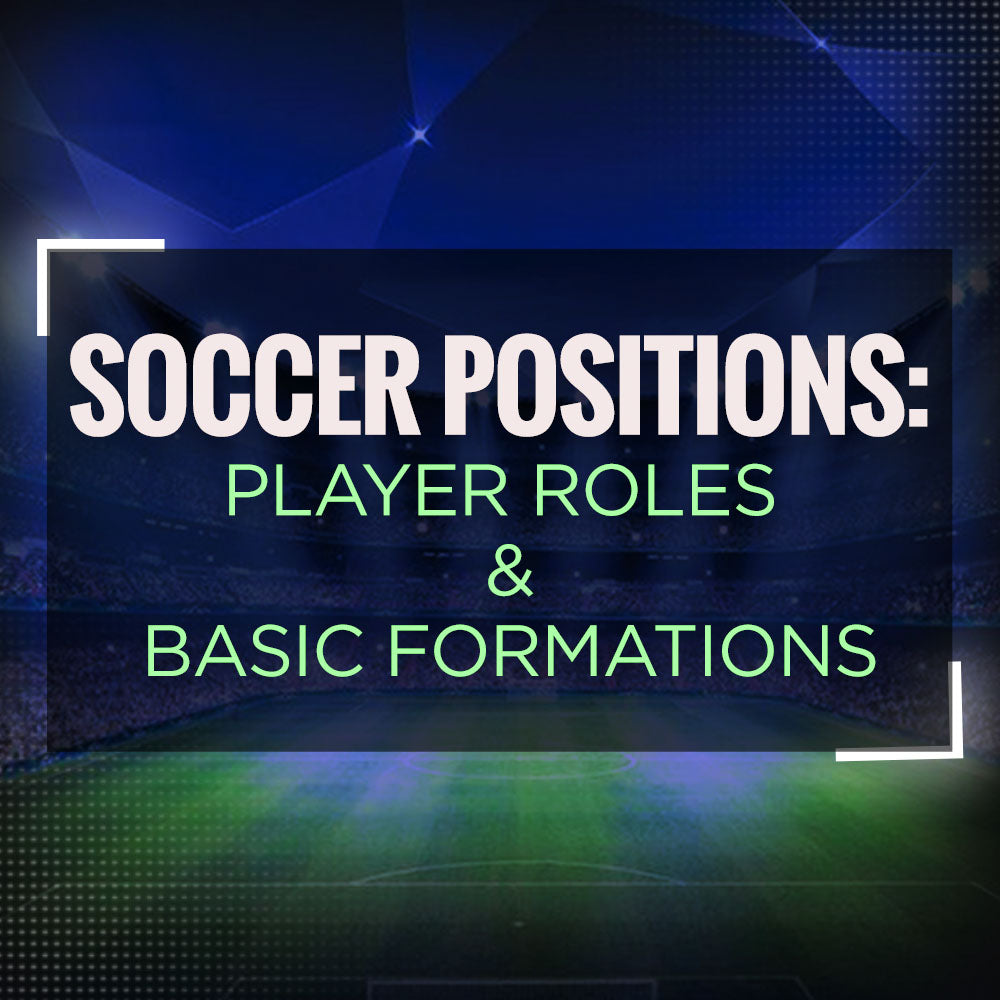THE BASICS OF SOCCER
PLAYER POSITIONS
“How Many Players On A Soccer Team?”
An average soccer squad consists of eleven players per team, with ten players whose job it is to stick to the outfield, plus one designated goalkeeper. Each team is split into offensive and defensive factions, which we will outline in greater detail below:Defense
A defender’s job is to contain the ball during game play, and dismantle the offense at crucial junctures. Defensive midfielders are especially helpful in this situation, as they are often highly proficient at passing and running (this also goes for defensive third). Center defenders, meanwhile, act as the foundation of the team: maintaining a steady equilibrium between players and keeping passing options open so that their team remains in control of the ball. Tackling is also a big part of defense – you don’t want to hurt your opponent, but you do want to prevent them from scoring! Central defenders often get aggressive with their tackling game; this is particularly true of defensive midfielders, who are attempting to keep the ball from reaching their team’s goal at all times. Goalies must be adept with dribbling and passing the ball as much as diving. The name of the game: don’t let the ball go through your team’s goal posts. This is a task that requires no shortage of physical dexterity and coordination, although it is often said that the goalie is the last line of defense to prevent the other team from securing a goal. In other words, your defenders should have eliminated the threat by then, but that’s not always how it goes. The goalie is almost always on defense, having a comprehensive view of the field of play, and a dynamic athletic range within that field of play; the goalkeeper is also the only player who is allowed to use their hands to direct the ball during game play. Observe a seasoned goalie’s drop kick to midfield to study how smart defensive goal keeping can alter the trajectory of a game to a certain team’s advantage. Goalkeepers also act as a communicative in-between for other members of the team, and are a valuable component of a soccer squad for that reason alone.Midfielders
It is the midfielder’s duty to ensure that the opposing team doesn’t get too close to their team’s goal. If so, they are to prevent them from scoring at all costs. Coaches will typically layer midfielders in the defensive end in the field, as a kind of backup security policy in case the goalie is having an off night. Midfielders, as any true soccer fan knows, are tackling machines, and it could be argued that their entire job is to stay on the opposing team like white on rice. There are left, right, and central midfielders, all of whom are constantly working to find passes that can expose holes in the opposition’s defense. A fine method of doing this is driving the players to the sides of the field and preventing them from landing an easy kick – and, therefore, an easy goal.Offensive Players
There are a few varieties of offensive players in soccer: for instance, there are Forwards, also known as Strikers, whose main job is putting points on the board. A forward doesn’t usually get too close to the goal in comparison to their own midfield line, as they play much of the game around said line, in accordance with the other team’s defense. There are also varying kinds of forwards/strikers, including center strikers (who plays closest to the opposition’s goal), as well as second strikers, wingers, and more.Formations
Defensive Formations
The 5-3-2
This formation is another one that requires on not giving up too many goals: it’s one that many allegedly “lesser” teams sometimes deploy to earn an advantage by attacking their opponents’ strategies with greater frequency (Brazil arguably won the 2002 World Cup by making repeated use of this tactic). This formation makes crucial use of three central defenders, with one acting as a sweeper, plus two wing-backs whose jobs is to ensure power in numbers on the defensive side. This makes a counteroffensive from the opposition’s end all but impossible.The 4-2-3-1
The 4-2-3-1 offers defensive stability and offensive advantage, particularly if you have adequate support from your midfielders, and also a powerful center forward. In this formation, players often play in rows of four, which allow them to deftly react to the offensive maneuvers. The hope is that the offense passes inwards, at which point a midfielder could theoretically intercept and gain control of the ball.Offensive Formations
The 4-4-2, “Diamond Formation”
The 4-4-2, also known as the “diamond formation,” is also one of the most efficient and rudimentary formations in the game. It requires work from two central midfielders to essentially keep tabs on both offensive and defensive sides; the formation also makes use of dual strikers, who are often responsible for bringing the play to its rousing finish.The 4-5-1
The 4-5-1 is a terrific offensive formation that mostly requires the defensive side to wait for the other team to screw up before exposing their vulnerabilities. As such a possession advantage is unlikely, but in terms of winning a game through slow, methodical deliberation, you could do worse (in that regard, this formation is similar to the 4-3-3 formation). The 4-5-1 really rests on the shoulders of the striker, since they will be handling the ball for the formation’s duration.What is the hardest position in soccer?
This is a question that frequently opens itself up to contentious debate. For example, you could easily present the argument that midfielders, many of whom run between three to nine miles in a single game, are doing the most work. Then there are the strikers and the fullbacks, all of whom have to exert an untold amount of physical effort during game play. There is a consensus, though, that the goalkeeper is arguably the most difficult and demanding job on the field – not just physically, but mentally. After all, they’re the ones who people blame for goals scored, and the trajectory of an entire game can rest on their efforts.Who runs the most in soccer?
Honestly, there is less overall debate about this issue, as many soccer players agree that midfielders are tasked with running the most over the course of a game. They are constantly in a position where they are either trying to attack or defend, which means that they are basically running the entire time – in kinetic motion, as it were. Midfielders are also frequently the targets of defenders, who try to feed them the ball and clear a “pitch” for the offense. While forwards only perform short bursts of printing, the midfielders run an average of seven miles per game!What is the fastest position in soccer?
The answer to this question largely depends on the style of the game being played, but the consensus is generally that wingers and fullbacks are required to be quick on their feet. There is also an argument that strikers are required to maneuver quickly during game play; the same is true of central midfielders, who are required to possess some level of mastery of every element of the game, including speed.Where can I learn more about soccer?
There are several rock-solid sources where you can either get your soccer news and updates or learn about the sport, including Goal.com, and the United Kingdom’s Four Four Two Magazine (elsewhere, this helpful primer breaks down the specifics and basics of soccer positions). That said, ProSoccer should be YOUR source for everything soccer-related, from mastering dribbling and passing drills, shopping for soccer cleats, or getting up to speed on your soccer-related literature. So, you know what to do: keep it locked to ProSoccer.com for all your soccer-related updates!Share on:





























